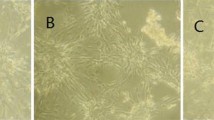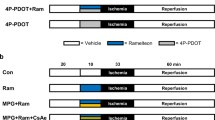Abstract
Substantial evidence suggests that pyroptosis is involved in renal, cerebral, and myocardial ischemia–reperfusion injury. However, whether pyroptosis is involved in ischemia–reperfusion injury of cochlear hair cells has not been explored. In this study, we examined the effects of melatonin on the oxygen–glucose deprivation/reperfusion (OGD/R) of hair cell-like House Ear Institute-Organ of Corti 1 (HEI-OC1) cells and cochlear hair cells in vitro to mimic cochlear ischemia–reperfusion injury in vivo. We found that melatonin treatment protected the HEI-OC1 and cochlear hair cells against OGD/R-induced cell pyroptosis and reduced the expression level of ROS in these cells. However, these effects were completely abolished by the application of luzindole (a non-selective melatonin receptor blocker) and largely offset by the use of ML385 (an nuclear factor erythroid 2-related factor 2 (Nrf2) inhibitor). These findings suggest that melatonin alleviates OGD/R-induced pyroptosis of the hair cell-like HEI-OC1 cells and cochlear hair cells via the melatonin receptor 1A (MT-1) and melatonin receptor 1B (MT-2)/Nrf2 (NFE2L2)/ROS/NLRP3 pathway, which may provide credible evidence for melatonin being used as a potential drug for the treatment of idiopathic sudden sensorineural hearing loss in the future.








Similar content being viewed by others
Data Availability
The datasets during and/or analyzed during the current study are available from the corresponding author on reasonable request.
References
Stachler RJ, Chandrasekhar SS, Archer SM, Rosenfeld RM, Schwartz SR, Barrs DM et al (2012) Clinical practice guideline: sudden hearing loss. Otolaryngol Head Neck Surg 146(3 Suppl):S1-35. https://doi.org/10.1177/0194599812436449
Kim JS, Lopez I, DiPatre PL, Liu F, Ishiyama A, Baloh RW (1999) Internal auditory artery infarction: clinicopathologic correlation. Neurology 52(1):40–44. https://doi.org/10.1212/wnl.52.1.40
Chandrasekhar SS, Tsai DB, Schwartz SR, Bontempo LJ, Faucett EA, Finestone SA et al (2019) Clinical practice guideline: sudden hearing loss (update) executive summary. Otolaryngol Head Neck Surg 161(2):195–210. https://doi.org/10.1177/0194599819859883
Liu L, Cao Q, Gao W, Li BY, Zeng C, Xia Z et al (2021) Melatonin ameliorates cerebral ischemia-reperfusion injury in diabetic mice by enhancing autophagy via the SIRT1-BMAL1 pathway. FASEB J 35(12):e22040. https://doi.org/10.1096/fj.202002718RR
Zang M, Zhao Y, Gao L, Zhong F, Qin Z, Tong R et al (2020) The circadian nuclear receptor RORalpha negatively regulates cerebral ischemia-reperfusion injury and mediates the neuroprotective effects of melatonin. Biochim Biophys Acta Mol Basis Dis 1866(11):165890. https://doi.org/10.1016/j.bbadis.2020.165890
Liu L, Chen H, Jin J, Tang Z, Yin P, Zhong D et al (2019) Melatonin ameliorates cerebral ischemia/reperfusion injury through SIRT3 activation. LIFE SCI 239:117036. https://doi.org/10.1016/j.lfs.2019.117036
Karaer I, Simsek G, Gul M, Bahar L, Gurocak S, Parlakpinar H et al (2015) Melatonin protects inner ear against radiation damage in rats. LARYNGOSCOPE 125(10):E345–E349. https://doi.org/10.1002/lary.25376
Karlidag T, Yalcin S, Ozturk A, Ustundag B, Gok U, Kaygusuz I et al (2002) The role of free oxygen radicals in noise induced hearing loss: effects of melatonin and methylprednisolone. Auris Nasus Larynx 29(2):147–152. https://doi.org/10.1016/s0385-8146(01)00137-7
Seidman MD (2000) Effects of dietary restriction and antioxidants on presbyacusis. LARYNGOSCOPE 110(5 Pt 1):727–738. https://doi.org/10.1097/00005537-200005000-00003
Lopez-Gonzalez MA, Guerrero JM, Torronteras R, Osuna C, Delgado F (2000) Ototoxicity caused by aminoglycosides is ameliorated by melatonin without interfering with the antibiotic capacity of the drugs. J PINEAL RES 28(1):26–33. https://doi.org/10.1034/j.1600-079x.2000.280104.x
Lopez-Gonzalez MA, Guerrero JM, Rojas F, Delgado F (2000) Ototoxicity caused by cisplatin is ameliorated by melatonin and other antioxidants. J PINEAL RES 28(2):73–80. https://doi.org/10.1034/j.1600-079x.2001.280202.x
Ding J, Wang K, Liu W, She Y, Sun Q, Shi J et al (2016) Pore-forming activity and structural autoinhibition of the gasdermin family. Nature 535(7610):111–116. https://doi.org/10.1038/nature18590
Liu X, Zhang Z, Ruan J, Pan Y, Magupalli VG, Wu H et al (2016) Inflammasome-activated gasdermin D causes pyroptosis by forming membrane pores. Nature 535(7610):153–158. https://doi.org/10.1038/nature18629
Shi J, Zhao Y, Wang K, Shi X, Wang Y, Huang H et al (2015) Cleavage of GSDMD by inflammatory caspases determines pyroptotic cell death. Nature 526(7575):660–665. https://doi.org/10.1038/nature15514
Liu D, Dong Z, Xiang F, Liu H, Wang Y, Wang Q et al (2020) Dendrobium alkaloids promote neural function after cerebral ischemia–reperfusion injury through inhibiting pyroptosis induced neuronal death in both in vivo and in vitro models. Neurochem Res 45(2):437–454. https://doi.org/10.1007/s11064-019-02935-w
An P, Xie J, Qiu S, Liu Y, Wang J, Xiu X et al (2019) Hispidulin exhibits neuroprotective activities against cerebral ischemia reperfusion injury through suppressing NLRP3-mediated pyroptosis. Life Sci 232:116599. https://doi.org/10.1016/j.lfs.2019.116599
She Y, Shao L, Zhang Y, Hao Y, Cai Y, Cheng Z et al (2019) Neuroprotective effect of glycosides in Buyang Huanwu Decoction on pyroptosis following cerebral ischemia-reperfusion injury in rats. J Ethnopharmacol 242:112051. https://doi.org/10.1016/j.jep.2019.112051
Wang M, Dong Y, Gao S, Zhong Z, Cheng C, Qiang R et al. (2022) Hippo/YAP signaling pathway protects against neomycin-induced hair cell damage in the mouse cochlea. Cell Mol Life Sci 79(2). https://doi.org/10.1007/s00018-021-04029-9.
Fu X, Li P, Zhang L, Song Y, An Y, Zhang A et al. (2022) Activation of Rictor/mTORC2 signaling acts as a pivotal strategy to protect against sensorineural hearing loss. Proceedings of the National Academy of Sciences 119(10). https://doi.org/10.1073/pnas.2107357119.
Zhang Y, Fang Q, Wang H, Qi J, Sun S, Liao M et al. Increased mitophagy protects cochlear hair cells from aminoglycoside induced damage. Autophagy 2022:1–17. https://doi.org/10.1080/15548627.2022.2062872
Zheng Y, Luo W, Ma R, Cong N, Ren D, Chi F et al (2020) The Atoh1 expression levels are correlated with the arrangement, ciliary morphology, and electrophysiological characteristics of ectopic hair cell-like cells. Neurosci Lett 720:134758. https://doi.org/10.1016/j.neulet.2020.134758
Takumida M, Anniko M (2019) Localization of melatonin and its receptors (melatonin 1a and 1b receptors) in the mouse inner ear. Acta Otolaryngol 139(11):948–952. https://doi.org/10.1080/00016489.2019.1655587
Miao ZY, Xia X, Che L, Song YT (2018) Genistein attenuates brain damage induced by transient cerebral ischemia through up-regulation of Nrf2 expression in ovariectomized rats. Neurol Res 40(8):689–695. https://doi.org/10.1080/01616412.2018.1462879
Zheng Z, Tang D, Zhao L, Li W, Han J, Hu B et al (2020) Liproxstatin-1 protects hair cell-like HEI-OC1 cells and cochlear hair cells against neomycin ototoxicity. Oxid Med Cell Longev 2020:1782659. https://doi.org/10.1155/2020/1782659
Yu P, Zhang X, Liu N, Tang L, Peng C, Chen X (2021) Pyroptosis: mechanisms and diseases. Signal Transduct Target Ther 6(1):128. https://doi.org/10.1038/s41392-021-00507-5
Frank D, Vince JE (2019) Pyroptosis versus necroptosis: similarities, differences, and crosstalk. Cell Death Differ 26(1):99–114. https://doi.org/10.1038/s41418-018-0212-6
Lee H, Lee HJ, Jung JH, Shin EA, Kim SH (2018) Melatonin disturbs SUMOylation-mediated crosstalk between c-Myc and nestin via MT1 activation and promotes the sensitivity of paclitaxel in brain cancer stem cells. J Pineal Res 65(2):e12496. https://doi.org/10.1111/jpi.12496
Onphachanh X, Lee HJ, Lim JR, Jung YH, Kim JS, Chae CW et al. (2017) Enhancement of high glucose-induced PINK1 expression by melatonin stimulates neuronal cell survival: involvement of MT2 /Akt/NF-kappaB pathway. J Pineal Res 63(2). https://doi.org/10.1111/jpi.12427
Ge H, Lin W, Lou Z, Chen R, Shi H, Zhao Q et al (2021) Catalpol alleviates myocardial ischemia reperfusion injury by activating the Nrf2/HO-1 signaling pathway. Microvasc Res 140:104302. https://doi.org/10.1016/j.mvr.2021.104302
Xu G, Zhao X, Fu J, Wang X. (2019) Resveratrol increase myocardial Nrf2 expression in type 2 diabetic rats and alleviate myocardial ischemia/reperfusion injury (MIRI). Ann Palliat Med 8(5):565–75. https://doi.org/10.21037/apm.2019.11.25.
Zou Y, Luo X, Feng Y, Fang S, Tian J, Yu B et al (2021) Luteolin prevents THP-1 macrophage pyroptosis by suppressing ROS production via Nrf2 activation. Chem Biol Interact 345:109573. https://doi.org/10.1016/j.cbi.2021.109573
Qiu Z, He Y, Ming H, Lei S, Leng Y, Xia ZY (2019) Lipopolysaccharide (LPS) aggravates high glucose- and hypoxia/reoxygenation-induced injury through activating ROS-dependent NLRP3 inflammasome-mediated pyroptosis in H9C2 cardiomyocytes. J Diabetes Res 2019:8151836. https://doi.org/10.1155/2019/8151836
Minutoli L, Puzzolo D, Rinaldi M, Irrera N, Marini H, Arcoraci V et al (2016) ROS-mediated NLRP3 inflammasome activation in brain, heart, kidney, and testis ischemia/reperfusion injury. Oxid Med Cell Longev 2016:2183026. https://doi.org/10.1155/2016/2183026
Wang X, Bian Y, Zhang R, Liu X, Ni L, Ma B et al (2019) Melatonin alleviates cigarette smoke-induced endothelial cell pyroptosis through inhibiting ROS/NLRP3 axis. Biochem Biophys Res Commun 519(2):402–408. https://doi.org/10.1016/j.bbrc.2019.09.005
Chen Z, Zhong H, Wei J, Lin S, Zong Z, Gong F et al (2019) Inhibition of Nrf2/HO-1 signaling leads to increased activation of the NLRP3 inflammasome in osteoarthritis. Arthritis Res Ther 21(1):300. https://doi.org/10.1186/s13075-019-2085-6
Funding
This work was supported by grants from the National Natural Science Foundation of China (No. 81970889 to FL.C) and the Science and Technology Committee of Shanghai (grant number 22S31903100 to FL.C).
Author information
Authors and Affiliations
Contributions
FLC, ZG, and NC contributed to conception and design of the study. YZ, NG, WXZ, and RM performed the experiments. YZ, NG, and WXZ wrote the manuscript. FLC, ZG, and NC reviewed and edited the manuscript. All authors read and approved the manuscript.
Corresponding authors
Ethics declarations
Ethics Approval
All animal experiments were performed in line with the principles of the Institutional Animal Care and Use Committee of the Eye & ENT Hospital of Fudan University.
Consent to Participate
Not applicable.
Consent for Publication
Not applicable.
Competing Interests
The authors declare no competing interests.
Additional information
Publisher's Note
Springer Nature remains neutral with regard to jurisdictional claims in published maps and institutional affiliations.
Supplementary Information
Below is the link to the electronic supplementary material.
Rights and permissions
Springer Nature or its licensor (e.g. a society or other partner) holds exclusive rights to this article under a publishing agreement with the author(s) or other rightsholder(s); author self-archiving of the accepted manuscript version of this article is solely governed by the terms of such publishing agreement and applicable law.
About this article
Cite this article
Zheng, Y., Gao, N., Zhang, W. et al. Melatonin Alleviates the Oxygen–Glucose Deprivation/Reperfusion-Induced Pyroptosis of HEI-OC1 Cells and Cochlear Hair Cells via MT-1,2/Nrf2 (NFE2L2)/ROS/NLRP3 Pathway. Mol Neurobiol 60, 629–642 (2023). https://doi.org/10.1007/s12035-022-03077-x
Received:
Accepted:
Published:
Issue Date:
DOI: https://doi.org/10.1007/s12035-022-03077-x




